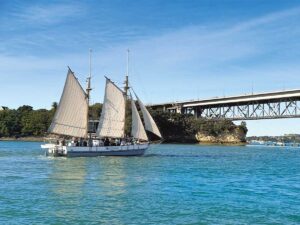Owners of caravans and motorhomes are explorers, people who venture outside the square to experience the diversity of the wider world. If they were once suburban nine-to-fivers, they certainly aren’t now.
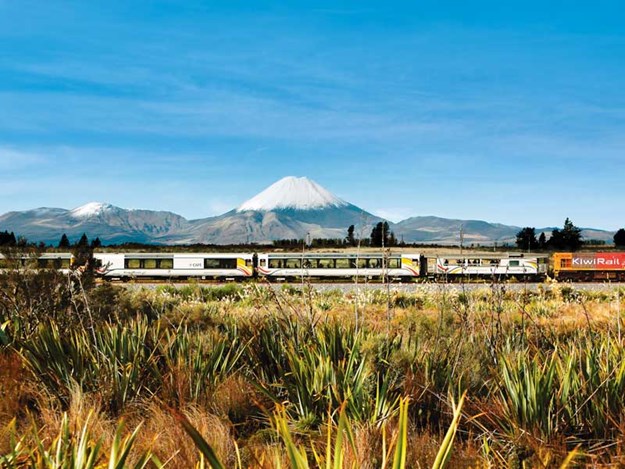 |
The Northern Explorer is one of the great train journeys of New Zealand |
I love being on the road with these ‘others’ who wittingly or unwittingly allow me glimpses of their lives, and enrich my travels with their yarns, their humour, and the appreciation of our shared islands. Not all their adventures involve RVs. Listen to their stories and you’ll hear about foreign travel, boating, cruising, flying, trekking and a host of other activities.
Our recent off-road excursion on the Northern Explorer was instigated by Richard, a fellow motorhomer whose lyrical description of his experience urged us to do the same. “See that part of the North Island from the train instead of the road,” he said, “and it’s a like being in a different country.”
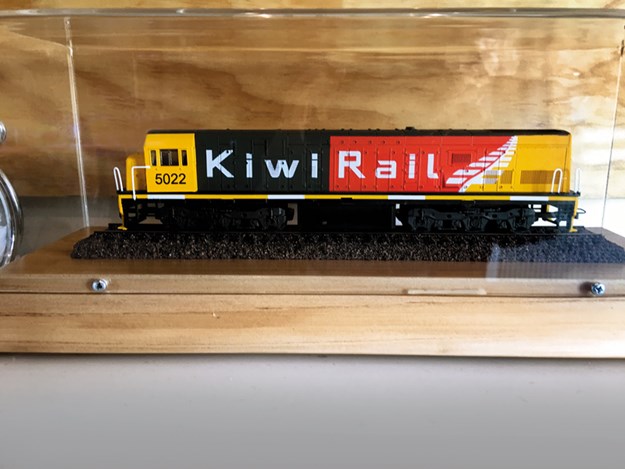 |
A model KiwiRail engine displayed in a glass case in the cafe car |
It took us a long time to get round to it, but last month we bit the bullet and booked the trip from Wellington to Auckland. We needn’t have done the whole journey.
On board we met a couple who’d left their caravan in Wellington, intending to disembark at Taumarunui, stay a night in an Airbnb and catch a bus back to Wellington next day. Our travel time was billed as 10-and-a-half hours. That’s as long as a flight to Bangkok. Flights of that length are desperately tedious, but on the train it was the time that flew.
 |
The start point, Wellington Station on Bunny Street |
At 7.45 in the morning, we’d entered Wellington Station on Bunny Street. Beneath its striking columns commuters were pouring towards the city like droves of rats. I’m a recovered rat racer, and it pleased me to think I was moving against the flow to join my fellow travellers standing expectantly on platform nine next to their large suitcases.
All aboard. The guard blew his whistle with ear-piercing vigour; a forlorn moan came from the engine, and the train slid quietly out of the station and shortly into a long tunnel. When we burst into the light again, we were on the Kapiti Coast, flat and grey under a ceiling of bruised-looking cloud.
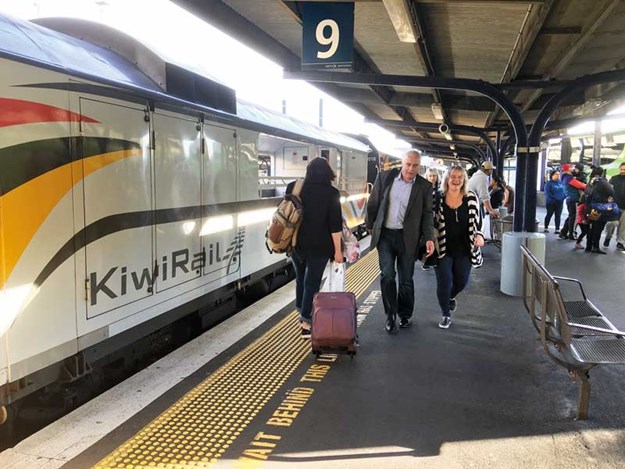 |
Escaping, not joining, the city’s morning rush... so satisfying |
The blotch of Kapiti Island broke the horizon and, as we travelled north, the majestic Tararua Range, stretching north to the Manawatu Gorge, reared towards the sky. The tops wore beanies of cloud.
I checked out the dining car, which I felt might be pivotal to my enjoyment of the trip. It was no Orient Express but was well stocked with a packaged Wishbone selection and, more importantly, a good espresso coffee machine.
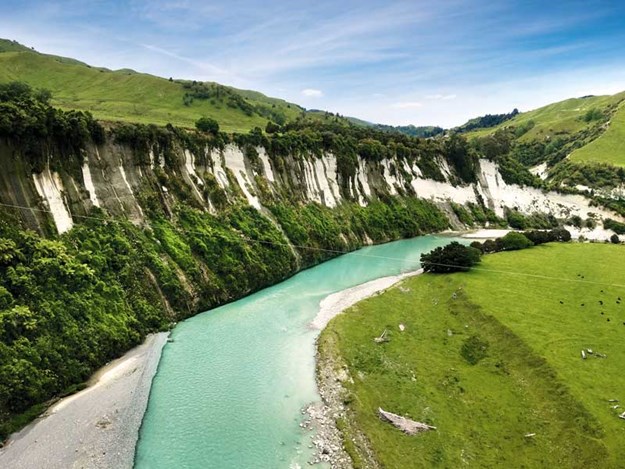 |
A long stretch of the Mangaweka Gorge |
It was also home base for the head hostess, Simone. She was a jolly, motherly woman who set the tone with her wide, obliging smiles.
The carriages have large windows and skylights and the seats are relatively comfortable, depending how long you sit on them. I was more often up than down as I hurtled back and forward to the observation carriage to catch the stunning features of the scenery through the Rangitikei and the King Country.
 |
Emerging onto the Kapiti Coast from the long first tunnel |
Richard was right; it’s a very different aspect than the one from the road. Dense gloomy forests, ridged escarpments and plunging gorges unfolded in an endless video as we carved our way through that dramatic countryside.
In between the wild features spread voluptuous pastures divided by leaning fences and dotted with isolated homesteads that looked diminutive in the overwhelming landscape.
 |
A passenger focuses on the vividly green and ever-changing landscape |
The North Island Main Trunk line (NIMT) has been called an engineering miracle and I could see why. On the 682km journey there were 352 bridges,14 tunnels and nine major viaducts, five of them over 70 metres high. As we approached one of these towering structures, excitement among the passengers began to mount.
And then we were gliding over it, as high as spiralling hawks with the knowledge that the only thing suspending us was a very tall engineering phenomenon. The view into the plunging ravines was spine-tingling or, if I let my imagination wander, quite terrifying.
It is hard to put a finger on where the King Country begins and ends. It’s a territory, not an official place, but roughly seems to stretch between Waikato and Taranaki including National Park, Mt Ruapehu and the Kawhia Harbour.
 |
The broken landscape of the Mangaweka Gorge |
It’s also known as ‘Te Rohe Potae (area of the hat)’, referring to the time in the 19th century when King Tawhiao, who was exiled there during the Maori Wars, threw his hat down on a map and decided that its rim defined the boundaries. Either he must have had a large hat or the map was very small. In any event, Maori sovereignty was asserted over the region. In Otorohanga and Taumarunui hatted street monuments commemorate the event.
Just after we left National Park, we entered the Raurimu spiral. This crafty bit of railway engineering on the Main Trunk Line is apparently the talk of railway buffs around the world.
It was designed in 1898 by a surveyor called Robert Holmes, who addressed the knotty problem of getting a rail track up a 139-metre escarpment between the Volcanic Plateau and the gorge of the Whanganui River. It includes one horseshoe curve, two 90-degree curves, two tunnels and a full circle crossing over the longest tunnel.
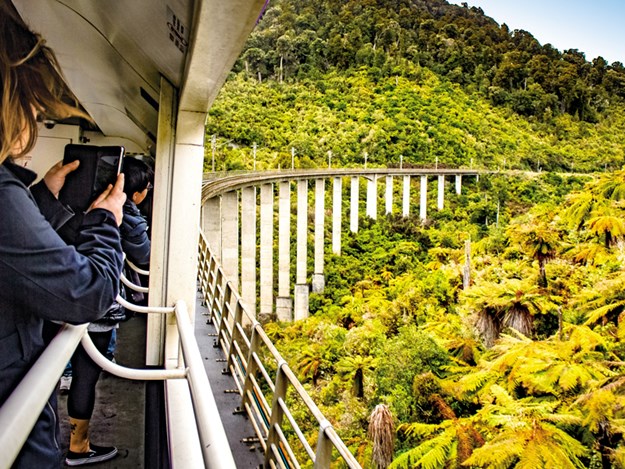 |
The spectacular parts of the country are best seen from the open-sided observation carriage |
I stood in the observation car, camera at the ready, expecting to photograph this roller-coaster, but apart from the tunnels, I couldn’t make head nor tail of it.
Apart from the perspective, one of the things that differs from road travel is the relentless forward movement. Many times I’d like to have shouted ‘stop, pull over!’, as I’m wont to do on the road when I spot anything of interest, such as the glimpse I had from the train of the vast graveyard of rusting vehicles at Horopito.
The few stops on the NIMT were at stations along the way and then only to disgorge passengers who were ending their journey. Even jumping down from the train for a five-minute leg stretch would have been a dodgy exercise. Too slow on the up-jump and you’d have to wait two days to rejoin your carriage.
As the train snaked its way north through the rust-coloured landscape of the Central Plateau, I caught glimpses of the snow-drizzled slopes of Mt Tongariro and Mt Ruapehu.
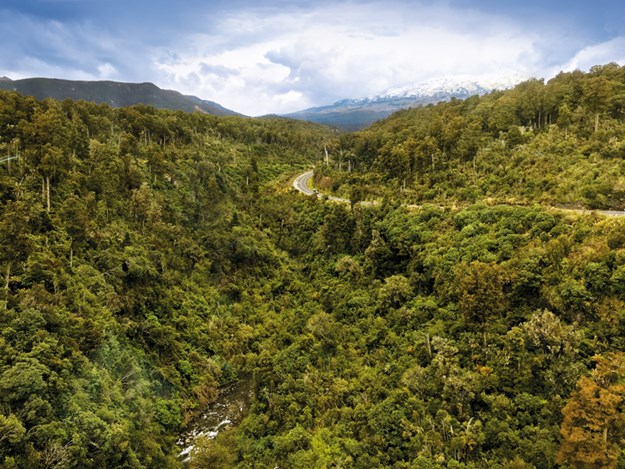 |
Mt Ruapehu sliding out from behind cloud cover |
The sun crept out from behind heavy cloud to give them an eerie glow. As the land flattened into the Waikato, so did my interest. I dozed as I drifted hazily towards home, just once coming to life for a moa’s eye view over the Waikato River that was straining against its banks and swallowing everything in the way of its path to the sea.
So for the last two hours we swayed through the swamp lands and the outlying areas of Auckland and it made for a timely respite. By then I was scenically saturated, and I slept or read and reflected on the journey.
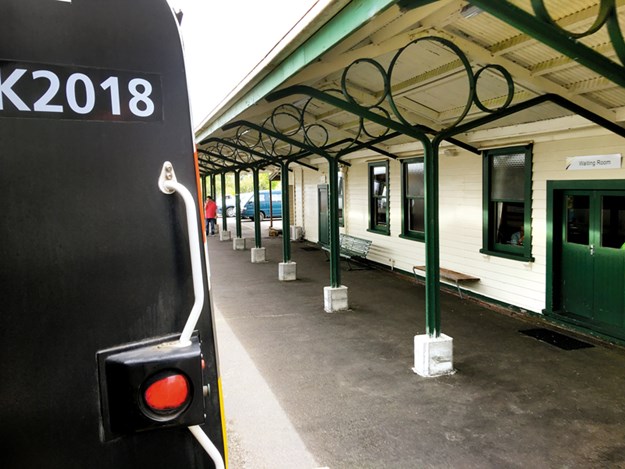 |
A short pause at one of the several country stations along the way |
Ten-and-a-half hours after we set off from Wellington the rain pulled unheralded into the Strand Railway Station in Auckland. There was no fanfare, none of the excitement of arrival. Passengers dribbled from the train dragging their luggage behind them and slowly dispersed.
Offer me a free ticket do the return trip to Wellington next day and I’d give it a miss. Maybe I’ll never do the whole length of the NIMT again. But I’m pleased I have, and I can tick it off the list. It was definitely a worthwhile adventure.


